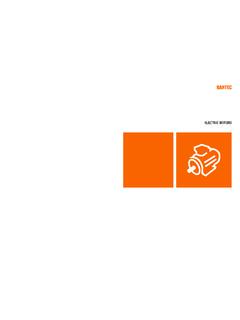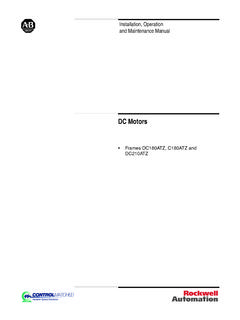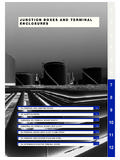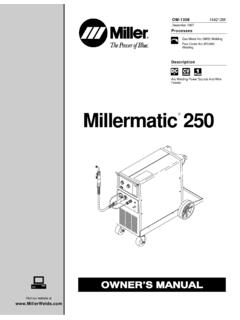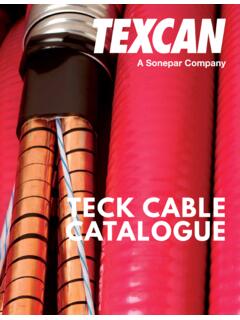Transcription of Explosion Proof Motor Classifications - Flow Prod
1 UL AND CSA Explosion - Proof CLASSIFICATIONS1. Hazardous Locations Class I Group D locations are atmospheres containing elements such as Gasoline, Hexane, Naphtha, Benzine, Butane, Propane, Alcohol, Acetone, Benzol, Lacquer Solvent Vapors or Natural Gas. Class I Group C locations are atmospheres containing elements such as Ethyl-ether, Ethylene and Cyclopropane. Class II Group F & G locations are atmospheres containing dust such as (F) Carbon Black, coal or Coke Dust, (G) Flour, Starch or Grain As required by Underwriters Laboratories and Canadian Standards Association, Explosion - Proof motors with Class II Group F & G approvals must have over temperature protection.
2 Explosion - Proof Motors rated 1 1/2 HP or less have internally mounted automatic thermal overloads when indicated by suffix A . Caution must be observed when applying these to machinery applications to prevent accidental injury should the thermal device automatically reset and restart the Motor . Explosion - Proof Motors rated 1 HP and larger without automatic thermal overloads have thermostats in the windings. These thermostats are pilot circuit devices to be connected to the magnetic starter Surface temperatures of Baldor Explosion - Proof Motors will not exceed the following UL and CSA maximums under fault conditions.
3 A. Class I, Group D listings only. 1 Motors with Class B insulation will not exceed surface temperatures of 230 C (446 F) equivalent Code T2C. 6 Motors with Class F insulation and will not exceed surface temperatures of 280 C (536 F) equivalent to Code T2A. B. Class I, Group C & D listings only. T Motors with Class F insulation and will not exceed surface temperature of 160 C (320 F) equivalent to Code T3C. C. Class I, Group D, Class II Group F & G listings. 3 Shunt wound DC motors, 182 through 215 frames, 1/2 through 3 HP, will not exceed surface temperatures of 165 C (329 F) equivalent to Code T3B.
4 U Fractional HP motors in Baldor type 35 will not exceed surface temperatures of 135 C (275 F) equivalent to Code T4. U Frames 364T through 449T will not exceed surface temperatures of 135 C (275 F) equivalent Code T4. I Fractional HP motors in Baldor type 34, and 1 HP motors and greater built in Baldor type 35, frames 143T through 326T will not exceed surface temperature of 160 C (320 F) equivalent to Code T3C. I Fractional HP motors in Baldor type 34, and permanent magnet DC motors in Baldor type 34 and 35, will not exceed surface temperatures of 160 C (320 F) equivalent to Code T3C.
5 D. Class 1, Group C & D, Class II, Group F & G listings. W Baldor Frames 182T through 449T will not exceed surface temperatures of 135 C (275 F) Code T4. 4. Not suitable for applications in temperatures below -25 C (-13 F).5. All Explosion - Proof motors are supplied with Explosion - Proof UL and CSA approved conduit boxes as CAUTION: Only Explosion - Proof motors which are specifically approved and UL Listed for use on adjustable frequency drives can be used on inverters. See pages UL Classifications , Groups and DivisionsClassificationsUL classification for hazardous location motors is based on the atmosphere in which the Motor will be operating under normal conditions.
6 There are three major Classifications , each with unique atmospheric conditions: Class I for gases, vapors and/or flammable liquids Class II for combustible dusts Class III for ignitable fibers and/or filingsGroupsEach classification and atmosphere is broken into various groups. Groups are determined by ignitable volatility or explosiveness, and the concentration of the material present. The highest combustible atmosphere is Group A. Subsequent alphabetical Group designations are progressively less volatile, Group B, then Group C, etc. Following is a partial listing of atmospheres that relate to each Group: Group A: Acetylene Group B: Hydrogen, butadiene, ethylene oxide and propylene oxide, and equivalent hazardous material Group C: Cyclopropane, ethyl ether, ethylene and equivalent hazardous materials Group D: Acetone, alcohol, ammonia, benzene, benzol, butane, gasoline, hexane, lacquer solvent vapors, naphtha, natural gas, propane and equivalent hazardous materials Group E: Metal dusts including aluminum, magnesium and their alloys, and other equivalent hazardous materials Group F: Carbon black, charcoal, coal or coke dusts Group G.
7 Flour, starch, grain, combustible plastics and chemical dustsDivisionsDivisions are determined by the atmosphere that is present under normal operating conditions. Division 1 relates to an atmosphere that normally contains highly combustible 2 involves a normal atmosphere that is non-combustible, but can change due to an accident or equipment misapplied in hazardous environments can cause a fire or Explosion resulting in destruction of property, serious injury or death. Only the end user or a qualified underwriter is to identify and select the proper class, group, division, and temperature code Motor to meet the requirements of each installation.
8 Baldor personnel, agents and distributors can advise what listings and approvals Baldor motors carry, but cannot evaluate nor recommend what motors may be suitable for use in hazardous environments. Only Explosion - Proof motors which are specifically approved and UL Listed for use on adjustable frequency drives can be used on inverters. See pages Ratings and Code Numbers:Contact your local Baldor office for other Class and Group listings.
